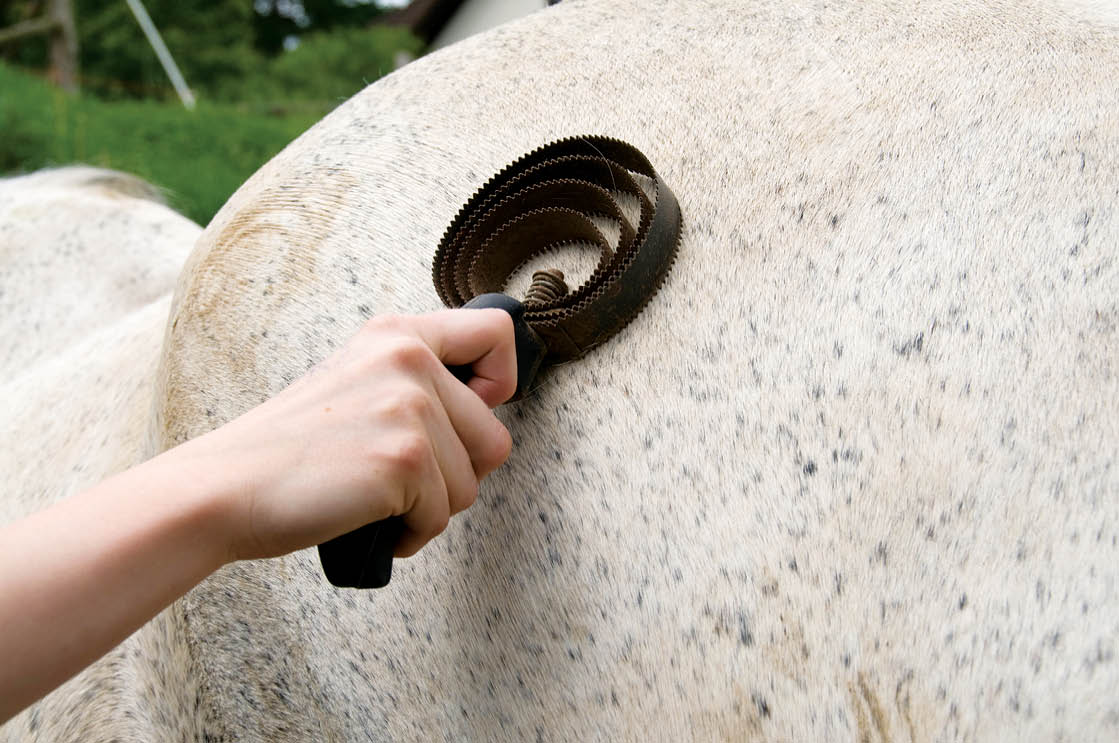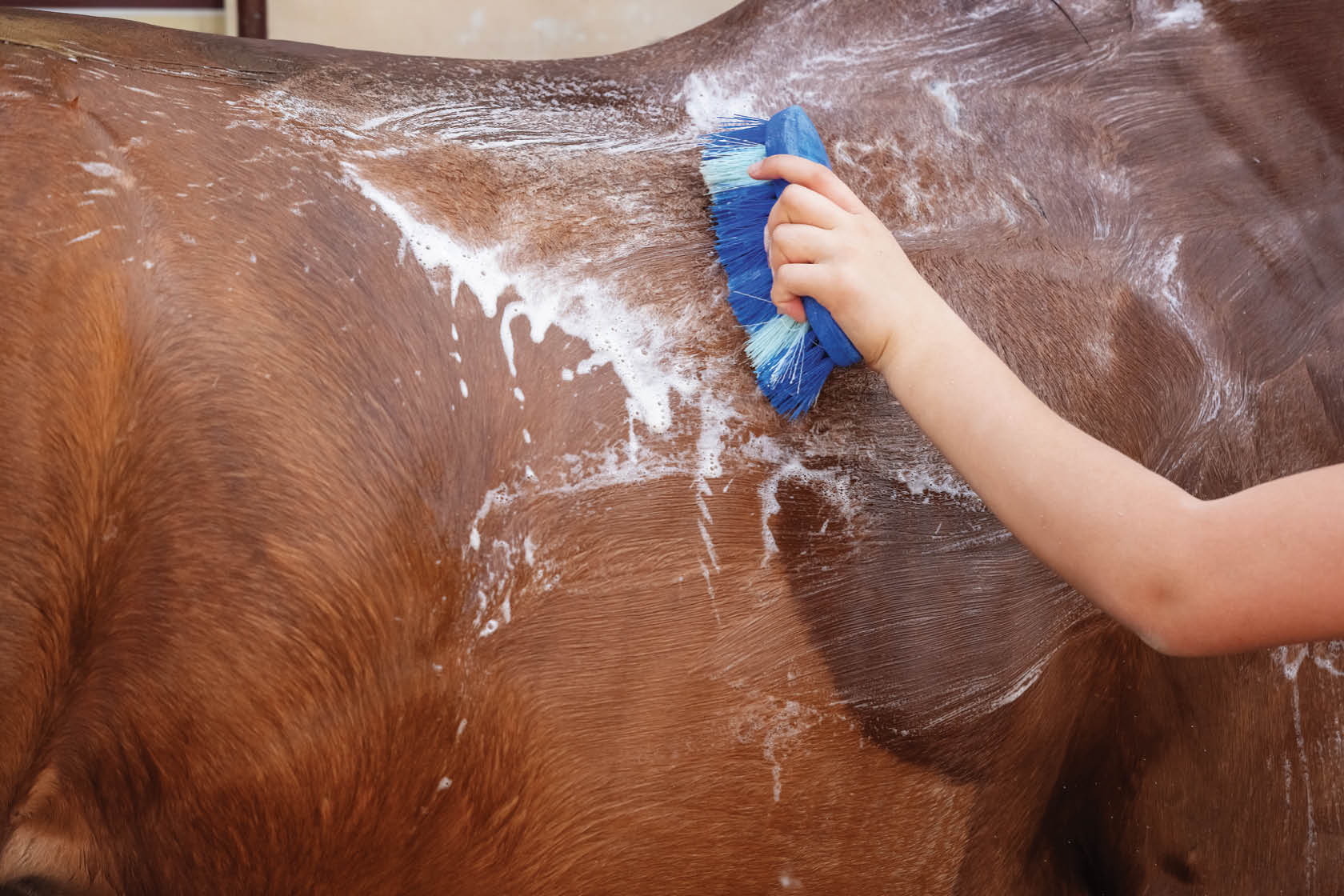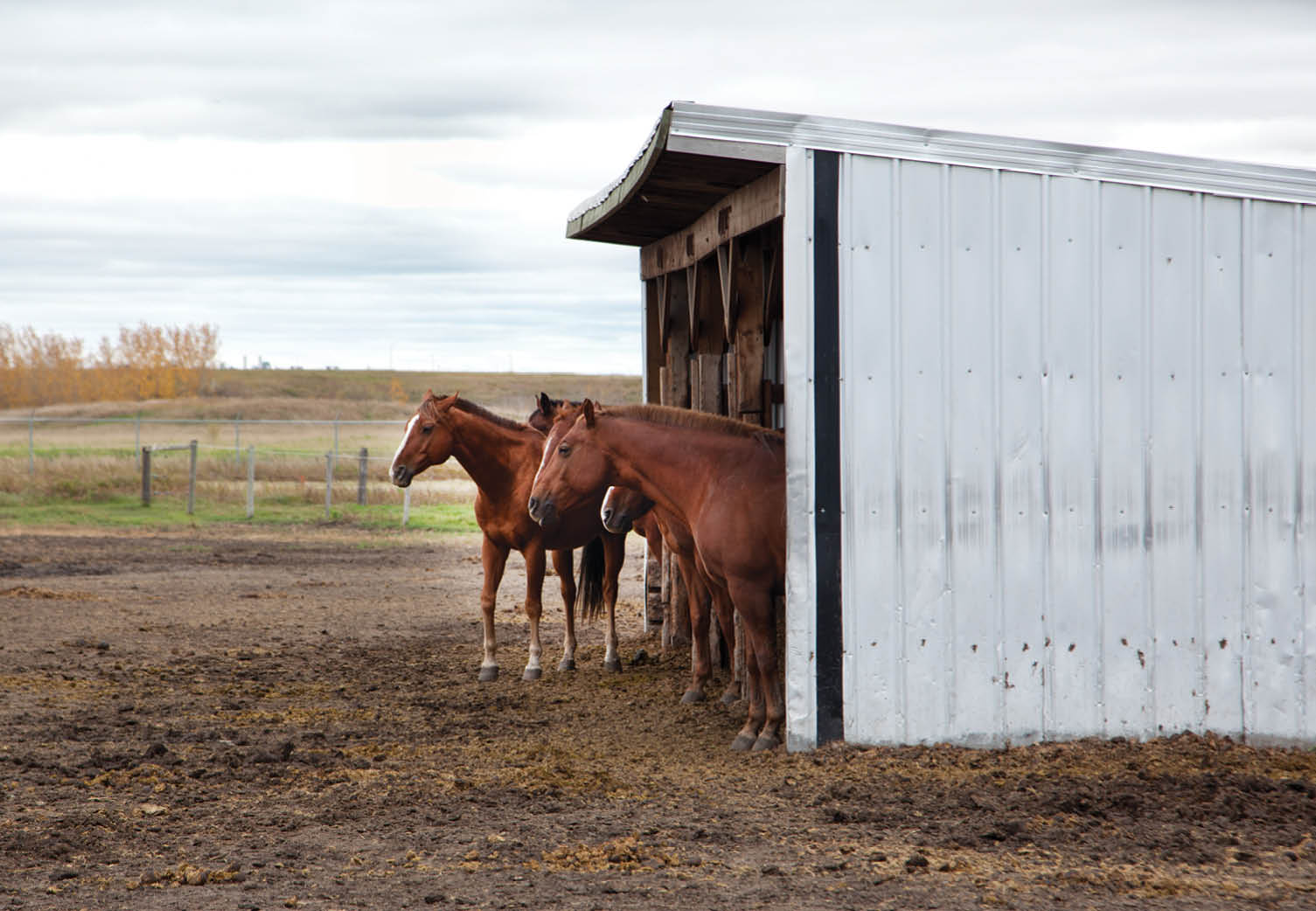Did you know that the skin is the largest organ in your horse’s body? In fact, the skin of an average 1,000-pound horse is likely to weigh 60 pounds, or 6% of his body weight. This amazing organ stays healthy by constantly replacing itself to perform its vital role of protecting your horse’s body. Dead skin cells on the surface slough away and are replaced with new, young cells in a cycle that takes about 17 days.
[READ: COMMON EQUINE SKIN PROBLEMS]
Why is it so important for your horse to have healthy skin? A sleek, shiny haircoat and luxurious mane and tail might be things of beauty, but the benefits of healthy skin go much deeper. His skin not only protects his sensitive underlying tissues but also has immune functions that help him ward off disease. This amazing organ also provides a mechanism to repel insects and detects outside stimuli, such as heat, cold, pain, and touch. Simply put, healthy skin means a healthy horse.

Here, I’ll start with an in-depth look at your horse’s skin. Then, I’ll give you a rundown of three challenges you and your horse must overcome to keep his skin healthy. Finally, I’ll outline a basic, seven-step skin-care routine designed to give your horse that healthy glow.
Skin Basics
Your horse’s skin is composed of two primary layers: the epidermis (outer layer) and the dermis (inner layer). The epidermis, just 0.05 millimeters thick, is composed of four important cell types: keratinocytes, Langerhans cells, melanocytes, and Merkel cells.
Keratinocytes are protective cells on the skin’s surface that are constantly being renewed. Newly created keratinocytes migrate from the lower layers to the skin’s surface. These cells become tougher through a process called keratinization.
Langerhans cells are part of the immune system. They recognize unknown invaders to help your horse fight off infection and destroy foreign substances.
Melanocytes produce melanin, the pigment that colors the skin and helps protect it from the damaging effects of sun. Merkel cells recognize the sensations of heat, cold, and touch. Together, these cells form the primary barrier that protects the inside of your horse from the outside world.
The dermis, or middle layer of the skin, ranges in thickness from one to six millimeters. The dermis is primarily made up of proteins (elastin and collagen) that provide a framework for blood vessels and nerves. These proteins also support hair follicles and sweat and oil glands.
The structures of the dermis provide physical protection, help control temperature, repel water, and support immune functions to protect against foreign invaders.
Beneath the dermis lies the subcutis (meaning “beneath the skin”). Although not considered truly part of the skin, this layer is still important when considering skin health. The subcutis is made up of fat and connective tissues that help support the dermis and epidermis, as well as the subcutaneous muscles that produce that all-important “twitch” response to repel insects.
Skin Gone Wrong
The health of your horse’s skin is challenged daily by everything from weather conditions (hot, cold, wet) to insect bites. These challenges can lead to a variety of problems that most commonly fall into three categories: (1) infections; (2) inflammation; and (3) trauma. These categories are often intertwined.
1. Infections. Microorganisms including bacteria and fungi can take up residence in your horse’s skin, leading to a skin infection. Such infections commonly involve swelling and pain. Your horse is at risk if he lives in an environment where conditions (such as extreme moisture) favor survival of these microorganisms, if he is in contact with other horses, or if he has some other, underlying skin condition that threatens skin health, such as an allergy or wound. Your horse might need an antimicrobial medication to cure his infectious skin condition.
2. Inflammation. Your horse might have a hypersensitivity or allergy to a substance that irritates his skin. During an allergic reaction, inflammatory cells release substances in the skin that cause damage. An inflammatory skin condition is often itchy, and is characterized by scabbing, crusting, and hair loss. If the itch is severe, your horse might cause a wound or abrasion when he tries to scratch himself. He’s at risk for inflammatory skin conditions if he has allergic tendencies or if he lives in an environment containing an abundance of potential allergens (allergy-producing substances). Inflammatory skin conditions typically require treatment with anti-inflammatory medications, such as corticosteroids, to heal.
3. Trauma. Wounds or abrasions that damage the skin surface are the third most common category of skin problems you’re likely to encounter. Skin injuries can be primary, putting your horse at risk for developing infections and inflammation, or secondary to another preexisting condition. Your horse is at risk if he has any other skin condition, wears any type of equipment (such as tack and blankets) on a regular basis, or lives in an unsafe environment. Essentially, your horse is at risk because he’s a horse.
Skin-Care Routine
It’s easy to see that skin challenges are everywhere in your horse’s world. Take the following seven steps to combat these challenges and keep your horse’s skin as healthy as possible.
Step 1: Feed him right. Healthy skin is clearly dependent on good, overall health—and what could be more important than a well-balanced diet? Adequate protein is particularly important for skin regeneration; your mature horse’s ration should contain 10% to 12% quality protein. The trace minerals zinc and copper are also specifically important for healthy skin. Zinc is required for cells to reproduce; copper plays a critical role in helping to maintain the structural integrity of collagen. Together, these two minerals also impact the production of melanin. Your typical 1,100-pound horse should have 50 milligrams of copper and 200 mm of zinc in his daily diet. Finally, omega fatty acids have wide-ranging skin benefits. Consider adding a supplement, such as flax seed (about 4 ounces daily), to your horse’s ration to boost skin health.
Step 2: Groom him well. Perhaps nothing has more of an impact on your horse’s skin than a good, regular grooming routine—and that means much more than a “quick brush.” Daily and vigorous use of a curry comb removes dirt and grime; encourages old, dead cells to slough away so they can be replaced; and stimulates production of oils. Daily currying can almost completely control some conditions, such as cannon bone seborrhea (that thick, grungy skin that forms on the front of the hind legs). And with daily grooming, you’ll identify any small wounds, crusts, or other abnormalities that might require attention before they become more serious problems.
To keep your horse’s skin healthy, curry his entire body (use a rubber mitt or soft-rubber curry comb for his face and legs), brush with a stiff brush to clear away debris, and finish with a soft brush or towel. If you have a white-pigmented horse, protect his sensitive skin with a sunscreen formulated for equines.
A word of caution: don’t share brushes! Many skin diseases are caused by microorganisms that can easily be passed from horse to horse. To best protect your horse’s skin, keep grooming tools separate and clean, and disinfect them regularly. (For how to disinfect your equipment, turn to page 100.)
Step 3: Bathe wisely. Is bathing good or bad? It depends. Bathing to remove caked-on dirt or rinsing off sweat after a hard workout can help keep skin healthy. (If your horse is at risk for tack rubs, apply a salt-water rinse, an old trick farmers used to toughen the skin of hardworking horses in the fields.)

Some horses can even experience an allergic reaction to their own sweat that leads to significant skin issues. When you rinse or towel off sweat, you can help prevent
problems. On the other hand, too-frequent shampoo baths can negatively impact your horse’s skin by stripping the natural oils. In fact, it’s best to give your horse a full-on shampoo bath as infrequently as possible.
What about shampoos? Is it best to use horse-only shampoo? Is baby shampoo easier on your horse’s skin? These are great questions—with unexpected answers. It’s true that the pH (a measure of acidity) is an important factor that can impact shampoo choices, but studies have shown that slightly more acidic shampoos are actually easier on the skin. Interestingly, horse skin is slightly less acidic than human skin, meaning shampoos designed for humans are probably acceptable to use on your horse.
However, avoid baby shampoos. These products are designed for small children with the primary goal of “no more tears,” meaning they’re typically less acidic than shampoos designed for adults (or horses). The result? Baby shampoos may actually be the most damaging choice for your horse’s skin.
Step 4: Beat down bugs. Insects are clearly public enemy No. 1 when it comes to healthy skin. Fly bites are bad enough—but an insect hypersensitivity (or allergy) can wreak serious havoc. An allergy to culicoides gnats (also called no-see-ums) can cause such serious itching that your horse might rub his mane and tail completely away, leaving behind raw, bloody skin.
[READ: 7 FLY-FIGHTING SOLUTIONS]
To protect your horse’s skin, mount a full-throttle control program as soon as insect season strikes. Include everything from environmental control (manure management and feed-through fly-control products) and insect barriers (fly sheets and masks) to vigorous use of fly repellents.
If your horse has experienced an insect hypersensitivity reaction in the past, ask your vet whether initiating treatment with medications to control inflammation (such as the corticosteroid prednisolone) before fly season even begins would be a good idea. And pay attention to the skin along the middle of your horse’s belly, where fly reactions typically show up first. Protecting this area with a barrier ointment before scabbing and itching even begins can help keep damage to a minimum.
Step 5: Clip with care. Body clipping might be necessary if you’ll be working your horse hard during winter months in a cold climate or moving your horse from a cold environment to a warmer one. Unfortunately, frequent body clipping can be hard on your horse’s skin. Body clip as few times as possible, and avoid clipping during shedding season if you want to encourage a healthy summer coat. If you do clip, consider leaving thicker hair behind where he’s more at risk for chafing, such as underneath the saddle. If you wear spurs, leave a protective patch of hair where your heels rest when you’re in the saddle.
Set aside these minimal-clipping guidelines if you have an older horse with a long, thick haircoat that doesn’t shed well (commonly seen in horses diagnosed with Cushing’s disease). A horse with this type of coat is likely to sweat excessively, and body clipping might actually help protect his skin.
Finally, if your horse stands in deep mud in his pasture or paddock, you might need to clip the hair around his fetlocks and pasterns to prevent scratches (also called mud fever) from developing. Note that in some situations, leaving hair in place on the lower legs might actually protect the skin from mud exposure. If you choose to leave the hair long, regularly check the underlying skin for signs of damage.
Step 6: Check your equipment. Something as simple as a cinch rub can put your horse out of commission for weeks—or even months. Your equipment should be clean and fit your horse well.
If your horse has sensitive skin, he might react to such manmade materials as neoprene. Check his skin daily after riding, and discontinue use of any piece of equipment that causes rubs or other signs of irritation. Horse blankets can be another source of skin damage. Make sure they fit correctly, and check underneath them daily for signs of trauma to the skin, such as a shoulder rub or wither sore.
Step 7: Control his environment. Control the environment where your horse lives and sleeps to help keep his skin healthy. Does he have shelter where he can escape the rain? Wet hair on his back can provide a perfect environment for microorganisms to thrive, leading to painful, scabbing, crusting skin conditions, such as so-called “rain rot,” which is caused by a bacteria called Dermatophilus congolensis.
[READ: VET’S TOP 10 MUD TIPS]

Is your horse standing out in deep mud during wet winter months? Soggy hair and skin on his lower legs can encourage infection with a mix of bacterial and fungal organisms commonly called “scratches” or “mud fever.” This painful skin condition often leads to extreme swelling and lameness, and can be difficult to treat once it becomes established.
And what about a place to lie down? If your horse lives in a stall, is his bedding deep enough? Thin bedding on an unforgiving surface can cause him to develop rubs on his hocks or fetlocks (bedsores). Over time, bedsores can develop into deep, painful wounds.
Finally, is your pasture fencing safe? Are your stalls well maintained? Anything that might cause a laceration, puncture wound, or any other injury can threaten skin health.
[READ: KNOW YOUR HORSE’S LUMPS & BUMPS]






